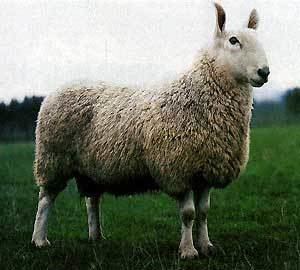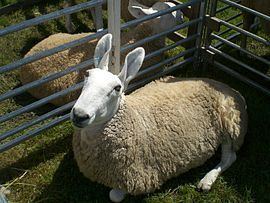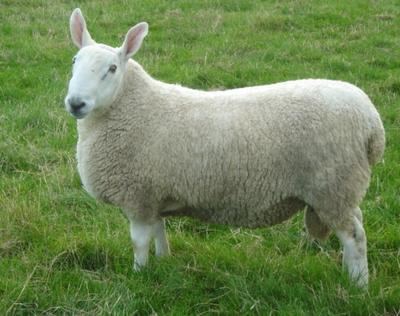Scientific name Ovis aries Rank Breed | Origin England | |
 | ||
Similar English Leicester sheep, Cheviot sheep, Suffolk sheep, Bluefaced Leicester, Romney sheep | ||
The Border Leicester is a breed of sheep that originated from England. Border Leicesters are polled, long-wooled sheep and are considered a dual purpose breed as they produce both meat and wool. Though large in size and robust, they are also docile. The breed has been exported to other sheep producing regions such as Australia and the U.S.
Contents
Description

The live weight of a mature Border Leicester ram will be in the range of 140–175 kg (309–386 lb) and a mature ewe 90–120 kg (200–260 lb). A yearling ewe is around 64 kg (141 lb). Their white wool tends to be very long and by Merino standards, broad crimped, and in fineness about 32 to 38 microns, and is used for medium to heavy weight garments. This wool, though, is prized by spinners because of the crimp and lustre. The sheep are normally shorn twice a year when the wool has reached a length of around 100 mm (3.9 in). Lambs when shorn have an average of 1.8 kg (4.0 lb) of wool; yearlings have a larger body and can have as much as 3.2 kg (7.1 lb) at each shearing. The U.S., Australian and New Zealand Border Leicesters very rarely sport the extreme of British flocks. All strains of Border Leicesters are known for their docility. They produce good milk and are good mothers with a lambing percentage of about 150%.

Border Leicesters are all white with a distinct long body, well developed chest, well sprung ribs and a wide, strong back. The nose should be black and the ears should be large, upright and alert. Feet should also be dark in color. The head and legs should be free of wool and only covered in short white hairs making it easier for shearing. Sheep of this breed should also have a distinct roman nose much like the North Country Cheviot.

There are key strengths associated with the Border Leicester making them an excellent breed for farmers. They have excellent maternal characteristics meaning that they make good mothers while producing quality lambs. Lambs finish quickly due to their high growth rate and produce high quality, desirable meat. The breed is also hardy and easy to keep and manage.
History
The Border Leicester was developed in 1767 in Northumberland, England and has a long and dignified history. Their name derives from the fact that their birthplace is near the border of Scotland with their foundation stock being Dishley Leicester rams. The Dishley Leicester was created and bred by Robert Bakewell (1726-1795) by crossing the old lincolnshire breed with the leicestershire type sheep. The Dishley Leicester became very popular with local farmers. George and Mathew Culley bought some of Robert Bakewell's Dishley Leicesters and the breed was soon found on both sides of the border through sales held by the Culley brothers. Around the 1830s two distinct types of Dishley Leicesters were developing on the two sides of the border. The Culley brothers were crossing their sheep with Teeswater sheep while other farmers in different areas along the border were crossing with Cheviots. This variation in the breed resulted in the two being nicknamed the "Bluecaps" and the "Redlegs". Many farmers preferred the hardier redlegs and around 1850 this variation of the Dishley Leicester became known as the Border Leicester. They were a fairly common breed in the U.K. by the 19th century.
Internationally
Registered flocks are now found in England, Ireland, Scotland and Wales. Border Leicester sheep have been exported to British Guiana, Canada, China, Colombia, South Africa, France, Spain, Portugal, United States, India, Japan, Yugoslavia, Iran, Hungary, Russia, Turkey and Switzerland.
Border Leicester sheep were imported to Australia in 1871, where they now have a large number of stud flocks. Border Leicester rams are used for mating with Merino ewes to breed the first-cross mothers that are so valuable for the production of prime lambs. Border Leicester Merino cross ewes produced in this way offer the greatest overall performance when breeding meat type sheep, with a well proportioned carcase, high fertility, good foraging ability and good milk production.
Border Leicester Merino cross ewes are mated to shortwool rams (e.g. Poll Dorset or Southdown) to produce prime lambs, which grow rapidly to market weights and have the ideal carcase shape. The vast majority of Australian lambs produced for meat are bred in this manner.
Border Leicester sheep also contribute about 50 percent of the genetics used in the Gromark breed of sheep that were developed in Australia.
The breed was imported into New Zealand in 1859, and after refrigeration was introduced in the 1880s, the Border Leicester was used as a crossing sire to produce heavyweight lambs and wether mutton. The Border Leicester was later used to develop New Zealand's Border-Romney cross (Coopworth) and the Border-Corriedale (Borderdale) breeds.
The first breed association was formed in 1888 in the U.S. Currently, there are two associations: American Border Leicester Association and the North American Border Leicester Association. Breeders show their sheep at county shows and fairs throughout the year with a National Show being held annually at the North American International Livestock Exposition held in Louisville, Kentucky every November.
